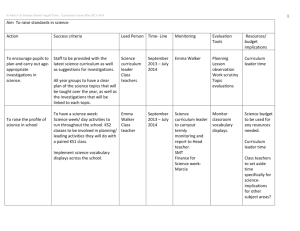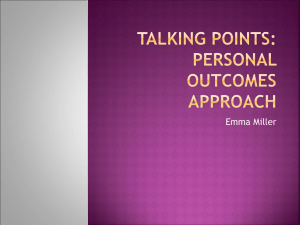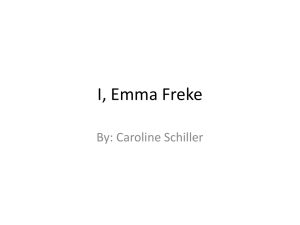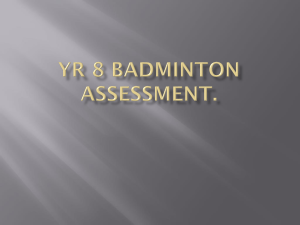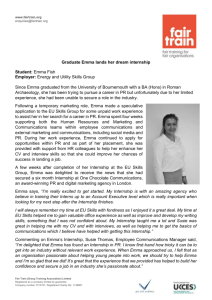Young Digital Planet 2014 – Core Curriculum for English
advertisement
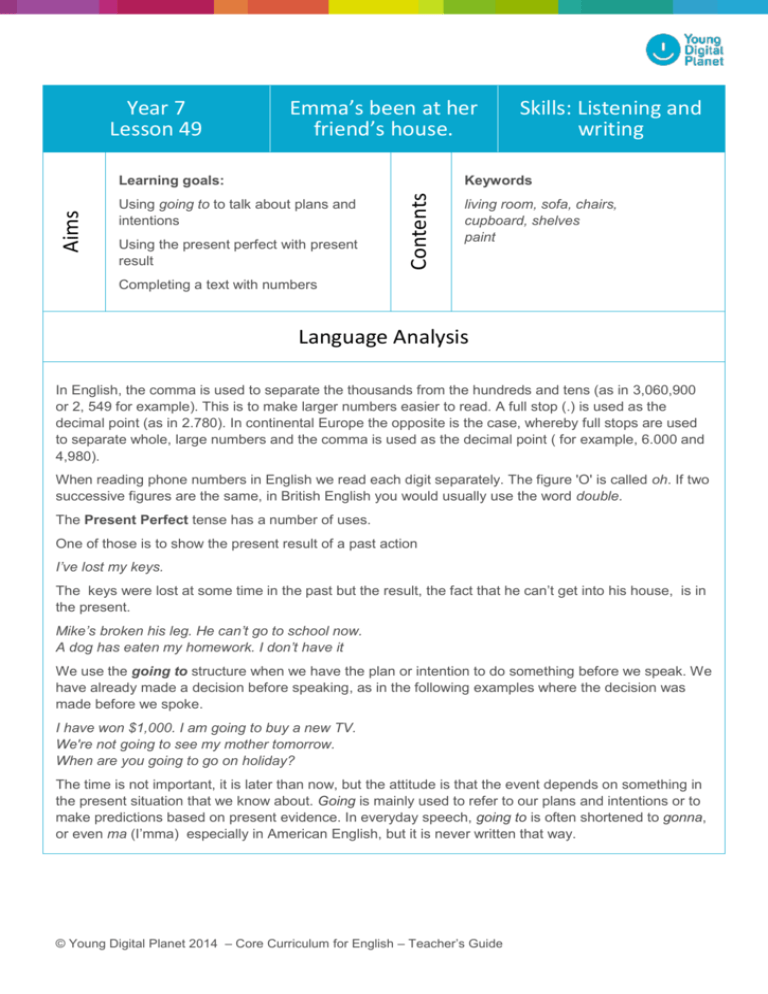
Year 7 Lesson 49 Emma’s been at her friend’s house. Keywords Using going to to talk about plans and intentions Using the present perfect with present result Contents Aims Learning goals: Skills: Listening and writing living room, sofa, chairs, cupboard, shelves paint Completing a text with numbers Language Analysis In English, the comma is used to separate the thousands from the hundreds and tens (as in 3,060,900 or 2, 549 for example). This is to make larger numbers easier to read. A full stop (.) is used as the decimal point (as in 2.780). In continental Europe the opposite is the case, whereby full stops are used to separate whole, large numbers and the comma is used as the decimal point ( for example, 6.000 and 4,980). When reading phone numbers in English we read each digit separately. The figure 'O' is called oh. If two successive figures are the same, in British English you would usually use the word double. The Present Perfect tense has a number of uses. One of those is to show the present result of a past action I’ve lost my keys. The keys were lost at some time in the past but the result, the fact that he can’t get into his house, is in the present. Mike’s broken his leg. He can’t go to school now. A dog has eaten my homework. I don’t have it We use the going to structure when we have the plan or intention to do something before we speak. We have already made a decision before speaking, as in the following examples where the decision was made before we spoke. I have won $1,000. I am going to buy a new TV. We're not going to see my mother tomorrow. When are you going to go on holiday? The time is not important, it is later than now, but the attitude is that the event depends on something in the present situation that we know about. Going is mainly used to refer to our plans and intentions or to make predictions based on present evidence. In everyday speech, going to is often shortened to gonna, or even ma (I’mma) especially in American English, but it is never written that way. © Young Digital Planet 2014 – Core Curriculum for English – Teacher’s Guide Procedure Lead-in Key: Ask students which room Emma and her mum are in. Ask them to look at the picture and label the furniture. © Young Digital Planet 2014 – Core Curriculum for English – Teacher’s Guide Main input Audio: Emma’s mum: I think this living room is looking old. We need to decorate it. Emma: I agree. What are you going to do? Emma’s mum: I’m going to paint the walls purple and I’m going to put some pictures on the walls. I’m going to buy a new sofa and I’m going to paint the chairs. Emma: My cousin Neil can help too – he’s a decorator! Emma’s mum: Good idea! I’ll phone him. And I want to tidy up the place so I need someone to make some shelves. Emma: I’m going to be in town today with my friends so I can look at paint colours if you like! Emma’s mum: OK, see if you can get a paint colour sheet. Emma: OK! Key: Emma and her mother are going to decorate the living room. Ask students to listen and match the questions with the answers. What is Emma’s mum going to do? She’s going to decorate the living room. What colour is she going to paint the walls? She’s going to paint the walls purple. What is she going to buy? She’s going to buy a new sofa. What is she going to do to the chairs? She’s going to paint them. Who is she going to phone? She’s going to phone her cousin Neil. He’s a decorator. What’s Emma going to do? She’s going to look at paint colours and get a paint colour sheet in town. © Young Digital Planet 2014 – Core Curriculum for English – Teacher’s Guide Practice 1 Audio: Emma’s mum: I think this living room is looking old. We need to decorate it. Emma: I agree. What are you going to do? Emma’s mum: I’m going to paint the walls purple and I’m going to put some pictures on the walls. I’m going to buy a new sofa and I’m going to paint the chairs. Emma: My cousin Neil can help too – he’s a decorator! Emma’s mum: Good idea! I’ll phone him. And I want to tidy up the place so I need someone to make some shelves. Emma: I’m going to be in town today with my friends so I can look at paint colours if you like! Emma’s mum: OK, see if you can get a paint colour sheet. Emma: OK! Ask students to listen and choose True or False. Key: Extension Emma’s mum’s not going to change anything in the living room. False Practise eliciting short answers from students asking them questions: Emma’s mum’s going to paint the walls blue. False Is Emma’s mum going to paint the walls blue? No, She isn’t Is Emma’s mum going to ask her cousin to help? Yes, She is. Is Emma going to be in town today? Yes , She is. etc. She’s not going to put pictures on the walls. False Emma’s mum’s going to ask her cousin to help. True Emma’s going to help her mum decorate. True © Young Digital Planet 2014 – Core Curriculum for English – Teacher’s Guide Practice 2 Audio: Emma: Hello? Neil: Hi Em! It’s Neil – how’re you doing? Emma: Great! How’re you? Neil: Really well! Is your mum in? She phoned me to ask me about decorating her living room. Emma: No, she’s not here, can I help? Neil: Yeah, can you take down some details for me? Emma: Sure, I’ve got a pen. Neil: Well, I can paint the room for her and my price is £200. Ask students to listen and choose the correct options from the drop down menu. Emma: OK. Neil: She asked me to find out the price of a new sofa at Hadley’s and it’s £435. They can bring it on 30 February if she orders next week. Emma: Great. Neil: And my friend, who builds shelves, says the price is £400. And he can start on 23 February. His phone’s number’s 663486. Please ask her to phone him. Emma: OK, I’ve written it all down and I’ll tell mum when she gets home. Neil: OK, thanks Em, bye! Emma: Bye! See you soon! Key: Neil is a decorator. Neil and Emma know each other well. Emma’s mum is out. Emma writes down the information. Neil has a friend who will build the shelves. © Young Digital Planet 2014 – Core Curriculum for English – Teacher’s Guide Practice 3 Audio: Emma: Hello? Neil: Hi Em! It’s Neil – how’re you doing? Emma: Great! How’re you? Neil: Really well! Is your mum in? She phoned me to ask me about decorating her living room. Emma: No, she’s not here, can I help? Neil: Yeah, can you take down some details for me? Emma: Sure, I’ve got a pen. Neil: Well, I can paint the room for her and my price is £200. Ask students to listen and complete the phone message with the numbers. Emma: OK. Neil: She asked me to find out the price of a new sofa at Hadley’s and it’s £435. They can bring it on 30 February if she orders next week. Emma: Great. Neil: And my friend, who builds shelves, says the price is £400. And he can start on 23 February. His phone’s number’s 663486. Please ask her to phone him. Emma: OK, I’ve written it all down and I’ll tell mum when she gets home. Neil: OK, thanks Em, bye! Emma: Bye! See you soon! Key: He can paint the room for £ 200. The new sofa at Hadley’s is £ 435. They can bring it on 30th February. Neil’s friend can build the shelves for £ 400. He can start on 23rd February. His telephone number’s 663486. © Young Digital Planet 2014 – Core Curriculum for English – Teacher’s Guide Practice 4 Audio: Emma’s mum: Did you have a nice time last night? Emma: Yeah. We went into town and then to Jane’s house – everyone was there, it was great. Emma’s mum: That’s nice. Do you like the new living room? I see you have painted the cupboard grey – it looks nice. Emma: That’s OK. You said you were going to paint the walls purple, but you have painted them blue – what happened? Emma’s mum: Neil painted them (he chose the wrong paint!), but I think it looks better than purple. Ask students to listen and colour. Then move the furniture to the room. Emma: Yeah, and you’ve changed the chairs to, yellow – that’s a good idea. So you’ve chosen a red sofa. It’s nice. Emma’s mum: Yes, it arrived yesterday. And Neil’s friend’s has built the new shelves. Your dad’s painted them grey. Emma: Well, it looks loads better than it did! Key: - cupboard grey - walls blue - wooden chairs in yellow - sofa red - shelves grey © Young Digital Planet 2014 – Core Curriculum for English – Teacher’s Guide Practice 5 Audio: Emma’s mum: Did you have a nice time last night? Emma: Yeah. We went into town and then to Jane’s house – everyone was there, it was great. Emma’s mum: That’s nice. Do you like the new living room? I see you have painted the cupboard grey – it looks nice. Emma: That’s OK. You said you were going to paint the walls purple, but you have painted them blue – what happened? Emma’s mum: Neil painted them (he chose the wrong paint!), but I think it looks better than purple. Ask students to listen and choose the correct answers. Emma: Yeah, and you’ve changed the chairs to, yellow – that’s a good idea. So you’ve chosen a red sofa. It’s nice. Emma’s mum: Yes, it arrived yesterday. And Neil’s friend’s has built the new shelves. Your dad’s painted them grey. Emma: Well, it looks loads better than it did! Key: Emma’s been at her friend’s house. Emma hasn’t been to a restaurant. Emma’s mum hasn’t painted the living room walls blue. Emma’s mum’s bought a new sofa. Emma’s dad’s painted the cupboards grey. © Young Digital Planet 2014 – Core Curriculum for English – Teacher’s Guide English to take away Audio: Emma: Hi Neil, have you had a good week? Neil: Yes, I have. What did you think of the new living room? Emma: It looks really nice. Neil: Yeah, it looks great in blue, doesn’t it? Emma: Yes. Are you going to come back next week to paint the kitchen too? Neil: I don’t know. I’m going to be really busy next week. My customers have asked me to do lots of jobs. Emma: Oh well, hope to see you soon! Key: Emma: Hi Neil, have you had a good week? Neil: Yes, I have. What did you think of the new living room? Emma: It looks really nice. Neil: doesn’t it? Ask students to listen to the dialogue and complete the sentences. Then instruct them to practise the dialogue in pairs. Emma: Yes. Are you going to come back to paint the kitchen too? Neil: I don’t know. I’m going to be really busy next week. My customers have asked me to do lots of jobs. Emma: Oh well, hope to see you soon! © Young Digital Planet 2014 – Core Curriculum for English – Teacher’s Guide Handout STUDENT A Numbers worksheet Ask STUDENT B questions to complete the sentences with numbers: 1. The Amazon River is 6400 kilometres long. 2. Monaco has a population of population of __________. 3. Mount Kilimanjaro is 5,895 metres high. 4. The Burj Khalifa building in Dubai is __________feet high. 5. Mount Everest 8,850 metres high. 6. The Chinese civilization is almost __________ years old 7. There are 18 holes in a round of golf. 8. There are __________ days in a fortnight. 9. There are 50 states in the US 10. There are __________ bones in the human body 11. There are 365 days in a year. 12. The United Nations has __________ official members. 13. The population of Beijing is 21,150,000 people. 14. Google processes over __________search queries every second. © Young Digital Planet 2014 – Core Curriculum for English – Teacher’s Guide Handout STUDENT B Numbers worksheet Ask STUDENT A questions to complete the sentences with numbers: 1. The Amazon River is __________ kilometres long. 2. Monaco has a population of population of 36,371. 3. Mount Kilimanjaro is __________metres high. 4. The Burj Khalifa building in Dubai is 2,716 feet high. 5. Mount Everest __________metres high. 6. The Chinese civilization is almost 4000 years old 7. There are __________ holes in a round of golf. 8. There are 14 days in a fortnight. 9. There are __________ states in the US 10. There are 206 bones in the human body 11. There are __________ days in a year. 12. The United Nations has 192 official members. 13. The population of Beijing is __________people. 14. Google processes over 40,000 search queries every second. © Young Digital Planet 2014 – Core Curriculum for English – Teacher’s Guide

